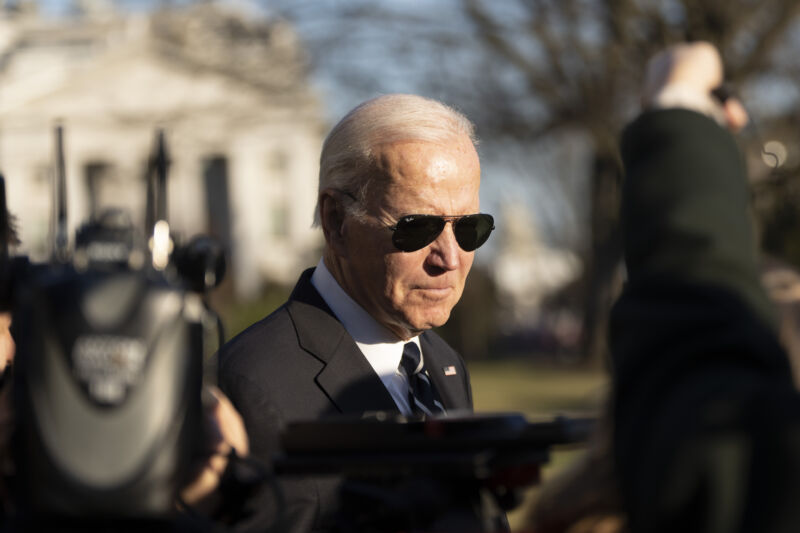
President Joe Biden plans to end two national emergency declarations over the COVID-19 pandemic on May 11, which will trigger a restructuring of the federal response to the deadly coronavirus and will end most federal support for COVID-19 vaccinations, testing, and hospital care.
The plan was revealed in a statement to Congress opposing House Republicans’ efforts to end the emergency declarations immediately.
“An abrupt end to the emergency declarations would create wide-ranging chaos and uncertainty throughout the health care system—for states, for hospitals and doctors’ offices, and, most importantly, for tens of millions of Americans,” the Office of Management and Budget wrote in a Statement of Administration Policy.
The Trump administration declared the two emergencies in 2020—a public health emergency was declared in January, and a national emergency was declared in March. They have been repeatedly renewed and are set to expire at different times over the next few months. The White House plan briefly extends them so they both end on May 11.
Though COVID-19 is still a significant public health threat in the US and worldwide, Biden’s plans to end the emergency phase of the pandemic response tracks with the thinking of other public health officials and experts. On Monday, the World Health Organization renewed its declaration that COVID-19 constitutes a public health emergency of international concern (PHEIC), its highest level of alert, but strongly signaled it will end the PHEIC in the near future. The agency said that the pandemic is nearing an “inflection point” in which enough population immunity to the virus—by vaccination and infection—has built up to warrant shifting the world out of an emergency phase. The WHO will revisit the PHEIC status three months from now.
COVID costs
In the US, more than 1.1 million people have died from the virus, which continues to kill hundreds of Americans each day. Currently, the average daily death toll is around 500, and hospitalizations are averaging over 30,000.
Eighty-one percent of all Americans have gotten at least one dose of a COVID-19 vaccine, while 69 percent have completed a primary series. But only 40 percent of people age 65 and older—those at high risk of hospitalization and death—are up to date with their vaccinations after the rollout of the bivalent booster shot last fall.
The majority of Americans have been infected with the virus previously. The latest estimates from the Centers for Disease Control and Prevention suggest that just under 60 percent of Americans have been infected with the virus at least once, based on blood antibody surveillance. Pediatric antibody surveillance suggests that 96 percent of children (6 months to 17 years) have antibodies against SARS-CoV-2 from infection and/or vaccination. Epidemiological studies continue to show that vaccination provides strong protection from severe disease and death, while “hybrid immunity” from both infection and vaccination offers the strongest protection of all.
The end of the emergency declarations will mean the phaseouts of federal COVID-19 relief funding, including federal funding for COVID-19 hospital care, an extension of Medicaid payments, free at-home testing, and COVID-19 vaccinations, among other things. Congress has extended pandemic-era telehealth benefits, however.
Planning for the transition of COVID-19 vaccines from federal supplies to the commercial market is already underway. Both Pfizer-BioNTech and Moderna have announced plans to dramatically hike the price of their COVID-19 vaccine doses by 400 percent for the commercial market—from roughly $26–$30 to $110–$130. Private insurance will cover the extra costs, while the uninsured may have to pay out of pocket. Additionally, with the federal emergencies ending, administration of the vaccines may also incur out-of-pocket costs, such as if insured people go out of network.
Pandemic pivot
In its own planning for the end of the emergency phase of the pandemic, the WHO stressed that SARS-CoV-2 is here to stay, necessitating the continued support of vaccination, access to medicine, surveillance of new variants, and readiness for the next outbreak.
“We remain hopeful that in the coming year, the world will transition to a new phase in which we reduce hospitalizations and deaths to the lowest possible level, and health systems are able to manage COVID-19 in an integrated and sustainable way,” WHO Director-General Dr. Tedros Adhanom Ghebreyesus said Monday.
Similarly, a trio of public health experts in New York addressed the pandemic’s turning point in a commentary piece in the New England Journal of Medicine last week, writing:
The current moment in the Covid-19 pandemic is a pivotal one. There is an urgent need to confront a future in which SARS-CoV-2 will remain with us, threatening the health and well-being of millions of people throughout the world. At the same time, it’s important to acknowledge that objectively we are in a better place with regard to the virus than we’ve ever been and that in fact many people believe the pandemic is behind us. This reality compels us to avoid using alarmist language and to offer valid and feasible solutions to bring people along to a new, nonemergency phase of the pandemic. How we craft our policies, programs, and associated messaging in this context and who delivers the messages is as important as ever.









